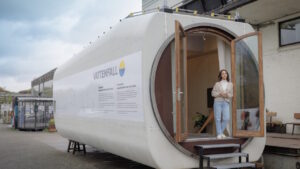The transition to 100 per cent renewable energy will be cheaper, quicker and easier than everyone thinks – that, at least, is the claim of one of Australia’s leading renewable energy data company’s and project developers, Windlab.
CEO Roger Price on Tuesday unveiled modelling from a detailed study undertaken by the company, a former spin-off from CSIRO, which shows that Australia could transition to 100 per cent renewables quickly, with less investment than most expect, and deliver a price considerable cheaper than now.
Using generation and demand data for the last two years in Australia, Windlab dialled in existing wind and solar, identified the best resources for more capacity, factored in existing hydro and then added in battery storage from household and large-scale plants, and from electric vehicles.
“We’ve built an enormous data set at 30 minute intervals at every node in the NEM (National Electricity Market),” Price told the Smart Energy Conference in Sydney on Tuesday. “We scaled up wind and solar where there is known wind and solar generation, and we can make those predictions and make them quite accurately.
“You always hear what is supposed to happen when the wind don’t blow and sun doesn’t shine. Let me tell you that is complete crap, that has absolutely never happened in the last two years.
“With the correct siting of wind and solar generation, and making use of differentiated resources that exist between east and west and north and south, we can get to a high penetration of renewable energy much cheaper, much quicker and more reliably than most people think.”
Windlab is a leading Australian renewable energy developer, responsible for the development and siting of some of the country best wind projects, and is also building the world-first wind-solar-battery storage facility at Kennedy in north Queensland, which could eventually become a 1200MW “baseload” renewable energy facility.
The results of its study will surprise many, including renewable energy enthusiasts.
Wind was scaled from 5.7GW to 32GW, supplying 54 per cent of NEM demand. Large scale solar was scaled from 2.6GW up to 16.7GW, supplying 21.7 per cent, while rooftop solar rose to 32.5GW, also accounting for around 22 per cent of NEM demand.
Only 28GW, or around 115GWh of daily storage was needed. This came from existing pumped hydro (22GWh), three million household batteries, and the ability to use 10 per cent of an electric car fleet of 10 million vehicles.
Surprisingly little was needed in the way of investments in transmission, Price says. The modelling suggested the Stage 1 upgrades recommended by the Australian Energy Market Operator would be needed to increase capacity between the major states, as well as the new link proposed for South Australia to NSW.
Price says the modelling shows that Tasmania’s “battery of the nation” project and a new link across Bass Strait would play a critical role in a future grid. “Basslink 2 is an absolute no-brainer and will help the transition to 100 per cent renewables,” he says.
He is less enthusiastic about the much vaunted Snowy 2.0 pumped hydro project put forward by the government-owned retailer Snowy Hydro. Price says it would be a hugely expensive outlay to provide more storage capacity than needed.
“We are only assuming relatively modest transmission investment,” he said. “We do need to make smart investments, but if we do it the right way, it will cost less than people think.”
This graph above shows how it meets the actual demand on the nem in 2018. The top graph looks at all contributions from wind and solar and storage, while the bottom one strips out the wind and solar and highlights only the use of storage and “other back-up.”
This second graph below covers two years of output and demand in the NEM, this time 2017 and 2018.
It highlights two problematic deficits and they didn’t appear in January or February as some might suggest, but in the middle of winter, which Price says can be more challenging because of lower wind power.
A gap of 6 per cent was identified. Price says this could be filled with pumped hydro or some other longer term storage, to soak up the curtailment of wind and solar (a total of 11 per cent spilled) at other times of the year. And there is also demand response. And no, he didn’t think Snowy 2.0 was the best response to that.
Price says that both wind and solar could deliver at around $50/MWh or lower. The average cost of firming is around $25 – cheap in Tasmania and Queensland, more costly in South Australia and Victoria. Other “back up” generation would cost around $155/MWh.
“When you put that together …you get firm renewable power for less than $70/MWh,” Price says That is for the 94 per cent renewable share modelled in this data set. Filling in the remaining 6 per cent could add some to costs, but there is opportunity from soaking up the 11 per cent of output that is curtailed.
Price says there is more work to do on the project and further refinements to be made. “We’ll be refining this work, and the scenario can be improved through more overbuilding of wind and solar, and a bias towards Queensland, NSW and Tasmania wind.”















